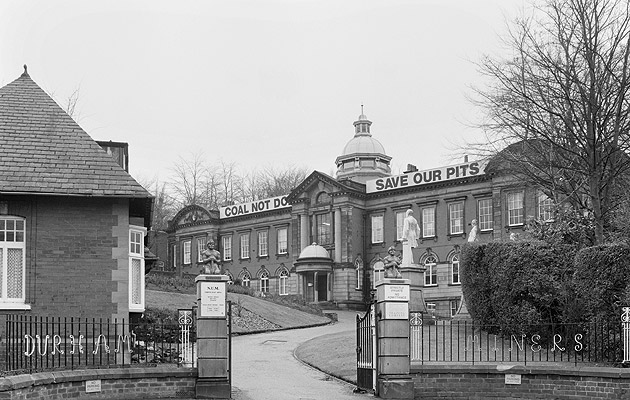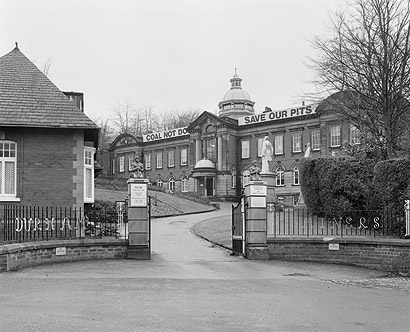|
Redhills, headquarters of the Durham Miners’ Association (image: English-Heritage) |
||
|
A book about socialist buildings is proof that construction need not be exploitative, says Owen Hatherley Architecture costs a lot of money. However “critical” or “subversive” it might like to think it is, it usually caters in some way to established power. This is a book about the exceptions – an illustrated compendium of rural communes, co-operatives, workers’ holiday camps, trade union headquarters and utopian communities, with not a wealthy philanthropist or well-meaning bureaucrat to be found. Curiously, this very seldom resulted in “anti establishment” architecture. Anyone led by the example of Russian constructivism or the Bauhaus to assume that radical politics equals radical architecture will be roundly disappointed by English Heritage’s colourful new volume, Buildings of the Labour Movement, by historian Nick Mansfield. From its cover image of the gruffly redbrick arts and crafts Cradley Heath Workers’ Institute onwards, the contents of this book are so worthy you can practically smell the home-made flapjacks. Worthy, but not dull. Covering the buildings in England built by and for socialists, communists, radicals and trade unionists from the late 18th century to the 2000s (the most recent building, Manchester People’s History Museum, is from 2009), it is full of surprises and tales of tragedy or farce, where architecture itself is often a little secondary. The sleek, city-centre, streamlined moderne department stores of the Co-operative Society aside, it avoids modern architecture, although something like Trellick Tower, say, has equal case to be considered a “building of the labour movement” – conceived by socialists in local government, designed by a communist, serving as social housing. The fact this sort of welfare state architecture doesn’t feature means Mansfield is free to range across some much more eccentric, and maybe more explicitly politicised buildings – spaces of agitation, not provision. The buildings of the utopian socialist “Owenite” movement, named after mill-owner and social dreamer Robert Owen, give no clue of the furious debates, flamboyant non-conformity and “illicit sexual practices” that apparently went on inside. The Huddersfield Hall of Science, one of their rare surviving structures, is an austere, pedimented classical building that could easily be mistaken for an especially stern Presbyterian church. Much the same is true of the various Mechanics’ Institutes built by less fervent radicals in the early-mid-19th century, their order and austerity making them rather inconspicuous – something that was probably useful, so as not to draw attention to their noncomformity. Similar motivations may be at work in the ill-fated “Chartist villages” of the 1840s, undemonstrative rural settlements where campaigners for universal suffrage could escape capitalism in the countryside – and, as landowners, could legally vote. The mainstream architecture of the day was employed without any qualms. The Socialist Institute in Nelson, Lancashire, a sandstone hall with stained glass and ever so slightly art nouveau details, could easily be a board school until you see the words “SOCIALISM, OUR HOPE” above the stained glass windows. When Burnley’s Labour Council decided to build a factory to tackle unemployment it went to Wallis Gilbert, the art deco designer of the Hoover Factory and its Californian-Egyptian ilk. Similarly, the Workers’ Travel Association went for deco, promising a little kiss-me-quick dash along with the ardent self-education. Some barely even bothered with their own buildings at all – the Labour Party, despite being by far the most powerful of the various institutions in this book, were especially uninterested in sponsoring architecture for its own use. Only the Co operative movement, commissioning dozens of stylish, strongly urban, even flashy buildings, seems to have cared much for aesthetics – probably a side-effect of its need to compete visually with private capitalist retailers. The buildings here that are listed for architectural rather than historical significance are almost all theirs. As Tony Benn (of course) points out in his preface, the real interest in these places is that they were “constructed or funded by the workers themselves”. They’re evidence that radical forces were strong, enthusiastic and confident enough to want to leave their mark on cities, towns and villages. They did so, without exploiting or screwing over anyone in the process. That, especially today, is hopeful enough.
Redhills, headquarters of the Durham Miners’ Association (image: English-Heritage) Buildings of the Labour Movement, By Nick Mansfield, English Heritage, £30.00 |
Words Owen Hatherley |
|
|
||





















